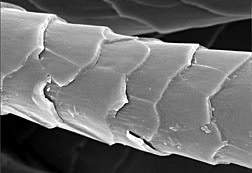https://oecotextiles.wordpress.com/category/fibers/wool/?blogsub=confirming#subscribe-blog
Here is a a snippet from the article:
THE FIBER:
In scientific terms, wool is considered to be a protein called keratin. Its length usually ranges from 1.5 to 15 inches (3.8 to 38 centimeters) depending on the breed of sheep. Fiber diameter ranges from 16 microns in superfine merino wool (similar to cashmere) to more than 40 microns in coarse hairy wools. Wool has several qualities that distinguish it from hair or fur: it is crimped (meaning it has waves), it has a different texture or handle, it is elastic, and it grows in staples (clusters).
Each wool fiber is made up of three essential components: the cuticle, the cortex, and the medulla.
- The cuticle is the outer layer. It is a protective layer of scales arranged like shingles or fish scales. They are sometimes described as little “barbs” because it’s the points of the scales that give wool the reputation for being prickly.
- When two fibers come in contact with each other, these scales tend to cling and stick to each other. It’s this physical clinging and sticking that allows wool fibers to be spun into thread so easily. And it’s also what causes the fiber to interlock – or felt. See below for more information on this.
- The cortex is the inner structure made up of millions of cigar-shaped cortical cells. The arrangement of these cells is responsible for the natural crimp unique to wool fiber. The amount of crimp corresponds to the fineness of the wool fibers. A fine wool like Merino may have up to 100 crimps per inch, while the coarser wools may have as few as 1 to 2. Hair, by contrast, has little if any scales and no crimp, and little ability to bind into yarn. Its wool’s scaling and crimp that make it easier to spin into yarn, because the individual fibers attach to each other, so they stay together.
- Rarely found in fine wools, the medulla comprises a series of cells (similar to honeycombs) that provide air spaces, giving wool its thermal insulation value.

Ooh, I never knew that wool had scales!
ReplyDeleteOoh, I never knew that wool had scales!
ReplyDelete